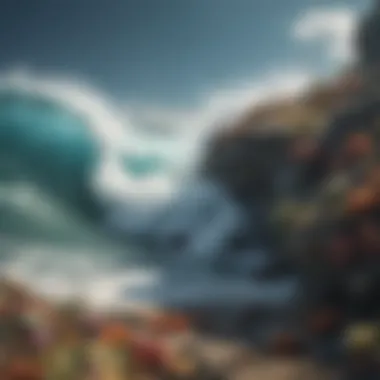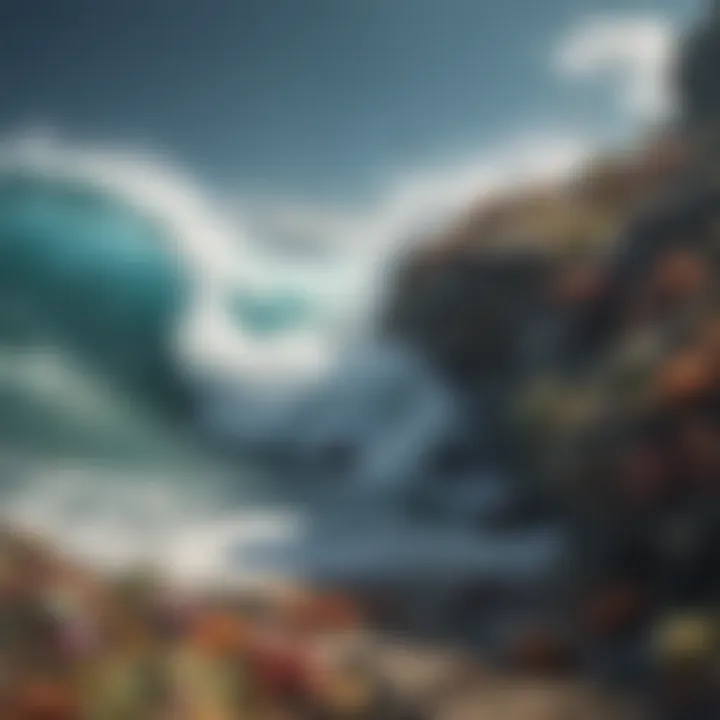Ocean Pollution: Understanding Its Impact on Ecosystems


Intro
The ocean is often called the lungs of our planet, supplying over half of the oxygen we breathe while also acting as a critical regulator of the climate. Yet, as surfers and outdoor enthusiasts may know, this vast blue expanse faces a crisis that threatens not only marine life but our own health as well. This article embarks on an exploration of ocean pollution, aiming to unravel its many threads—be it plastic waste, chemical runoff, or oil spills. By dissecting how these forms of pollution originate and cascade through ecosystems, we hope to empower readers with knowledge. It's more than just a dire subject; it is a call to action. Surfing aficionados, marine biologists, and local lifeguards alike can help mitigate these issues.
To navigate our journey effectively, we set sights on the critical points of concern, the latest statistics, and case studies showcasing both the crisis and the efforts made to combat it. Through this lens, we will see how pollution affects not just the fish beneath the waves, but our very existence, too. This is not an ordinary discussion about safeguarding the beaches; it takes into account every rider on the wave, every sea creature, and ultimately, every human being who depends on the ocean's health.
Surfboard Reviews
Although the main focus remains on ocean pollution, understanding the gear we use—surfboards—can also tie back to how our choices impact the environment.
Types of Surfboards: An Overview
When you're scouting for a board to catch those waves, it's key to understand what’s out there. Surfboards come in various shapes and materials, and each type can have unique implications for ocean health. To put it plainly, some boards might leach chemicals if they break down in the water.
- Shortboards: These are favored by experienced surfers for agility. Generally made from epoxy or polyfoam, they sometimes rely on materials that aren’t eco-friendly.
- Longboards: Great for beginners due to their stability, but often bulkier and can entail higher carbon footprints in construction.
- Soft-tops: Ideal for newcomers learning the ropes, they usually come at a lower cost and provide a safer ride.
Making conscious choices about what surfboards to use can be an effective step towards maintaining ocean health. It’s not just about the sport; it’s about the environment too.
Best Surfboards for Beginners and Pros
For those just starting or seasoned pros looking to refine their style, choosing the right surfboard can make a world of difference. Here’s a brief list that can help:
- Beginner-Friendly Boards:
- Advanced Choices:
- BIC Sport Mini Malibu: Sturdy and easy to balance on, perfect for catching small to medium waves.
- Wavestorm Soft Top: Affordable and forgiving; a popular choice among those just stepping into the surf.
- Channel Islands Rocket: Designed for speed and maneuverability, great for experienced surfers who want performance.
- JS Industries Monsta Box: A versatile board catering to various wave conditions, ideal for aggressive surfing.
Choosing a surfboard that's friendlier to both you and the ocean can have ripple effects beyond just your ride. Consider eco-conscious brands or those that use sustainable materials to minimize your environmental footprint.
Up next, we will delve deeper into the various forms of ocean pollution itself, examining the sources for a better grasp of this pressing issue.
Understanding Ocean Pollution
Ocean pollution is a pervasive and complex issue that bears significant implications not only for marine ecosystems but also for human health and the global economy. Its importance is underscored by the undeniable fact that oceans cover approximately 71% of the Earth's surface, providing vital resources and services. A deep understanding of ocean pollution enables stakeholders, from surfers to marine biologists, to appreciate the intricate web of connections between their activities and the health of marine environments.
Definition and Scope
Ocean pollution can broadly be defined as the introduction of harmful substances or pollutants into the marine environment. These contaminants can stem from various sources, originating either from land-based activities—like agricultural runoff and industrial waste—or marine-based operations, such as shipping and fishing.
The scope of ocean pollution is vast, encompassing several categories:
- Chemical pollutants: These include heavy metals, pesticides, and pharmaceuticals that seep into waters.
- Plastic waste: This involves everything from small microplastics to large debris that entangle marine wildlife.
- Nutrient loading: Excessive fertilizers wash into oceans, leading to eutrophication and dead zones.
- Oil spills: Accidental discharges that devastate local ecosystems.
Understanding the definition and scope allows one to track how pollution affects not just marine life but also coastal communities reliant on the ocean for their livelihood.
Historical Context
Looking back, the roots of ocean pollution can be traced to the Industrial Revolution, a time when humanity began to harness the oceans for economic gains with little regard for the environmental consequences.
In the early days, waste was simply dumped into rivers and oceans, considered vast enough to absorb any pollutants. However, as industrialization progressed, the stark reality became evident. Significant events, such as the Santa Barbara oil spill in the 1960s, triggered public awareness and government action, leading to the establishment of environmental policies.
The Sea Pollution Control Act and the establishment of the International Convention on the Prevention of Pollution from Ships (MARPOL) were some ground-breaking efforts aimed at curtailing Marine pollution.
Despite these advancements, the challenge has only grown with the rise of plastic use and climate change. Underestimating the historical context surrounding ocean pollution equips individuals and communities to grasp the current state of our oceans and the urgent need for collective action.
"The sea, once it casts its spell, holds one in its net of wonder forever." - Jacques Cousteau
Through understanding and learning from the past, we can work toward a more sustainable future for our oceans.
Types of Ocean Pollution
When it comes to understanding ocean pollution, getting the specifics right is crucial. Different types of pollution harm marine environments in unique ways, resulting in diverse ecological consequences. Grasping these types not only helps us appreciate the complexity of the issue but also highlights the urgent need for multifaceted solutions. This segment digs into four primary categories of ocean pollution: plastic pollution, chemical pollution, oil spills, and nutrient pollution, each carrying their implications for ocean health and the future of marine biodiversity.
Plastic Pollution
Plastic pollution has become a troubling symbol of modern waste mismanagement. Each year, billions of tons of plastic find their way into the ocean, threatening marine life and ecosystems. Think about it: plastic does not biodegrade; it only breaks into smaller particles called microplastics, which are swallowed by fish and other marine animals. These microplastics, they could end up on your dinner plate, indirectly affecting human health.
Not only does plastic harm marine life, but it also disrupts food webs. Small creatures, like plankton, which form the base of the marine food chain, ingest these particles, leading to lethal consequences. It's a ripple effect—over time, larger fish eat these smaller creatures, leading to increased toxicity higher up the food chain.


Key points about plastic pollution:
- It accounts for the majority of marine debris.
- Infamous for choking sea turtles and seabirds.
- Resilient enough to persist for centuries.
Chemical Pollution
Another layer of concern is chemical pollution. It includes a broad spectrum of toxic substances, such as pesticides, heavy metals, and industrial chemicals. These agents leach into the ocean from several sources: agricultural runoff, wastewater discharge, and even atmospheric deposition. Once in the water, they can have devastating effects on marine organisms—their reproductive systems, for instance, are highly sensitive.
Chemical pollutants, like mercury emitted from industrial activities, bioaccumulate as they move up the food chain. Consequently, species at the top end, like sharks and tuna, experience significant toxicity levels. This has big implications—not just for marine health but for the fishing industry that relies heavily on these species.
Chemical pollution highlights:
- Affects reproductive and immune systems of marine life.
- Chemicals like PCBs and DDT remain long after being banned.
- It’s linked to harmful algal blooms that can produce toxins harmful to marine life and humans.
Oil Spills
Oil spills are perhaps one of the most well-known forms of ocean pollution, notorious for their immediate and visible destruction. Oil pollution can stem from accidents—like tanker disasters—or from everyday activities such as routine spills during drilling operations. Oil floats on water and creates a thick barrier, blocking oxygen from entering marine ecosystems, leading to the suffocation of various aquatic life.
These spills have dire consequences for local economies, especially those reliant on fishing and tourism. Cleanup efforts are often costly and can take years, if not decades, to restore affected areas. The gruesome image of wildlife coated in oil serves as a stark reminder of the peril faced by our oceans.
Impacts of oil spills include:
- Loss of wildlife habitats.
- Long-term effects on species' reproductive health.
- Disruption of the economy for coastal communities reliant on fishing and tourism.
Nutrient Pollution
Lastly, nutrient pollution might not seem as glamorous as plastic or oil spills, but it’s just as devastating. It usually originates from agricultural runoff, as fertilizers leach into waterways and eventually reach the ocean. An overabundance of nutrients—particularly nitrogen and phosphorus—leads to a phenomenon known as algal blooms, which can deplete oxygen in the water and create dead zones where marine life cannot survive.
The repercussions are extensive: diminished fish populations and loss of biodiversity. Certain algal blooms can even produce toxins harmful to marine organisms and humans. It’s a domino effect, where disruption in one area leads to significant challenges down the line.
Important facts about nutrient pollution:
- Responsible for creating hypoxic zones (areas with low oxygen levels).
- Can lead to harmful algal blooms, producing toxins.
- Affects not just marine life, but coastal economies and public health.
Understanding these pollution types adds depth to our grasp of ocean health and emphasizes the necessity for ongoing education and action. The ocean isn't just a vast expanse of water; it's a complex, interconnected system that requires our attention and protection.
Sources of Ocean Pollution
Understanding the sources of ocean pollution is like peeling an onion—each layer reveals more about the underlying issues and complexities of the situation. It’s essential to grasp where the pollutants come from, as these insights can inform mitigation efforts and empower communities to take action. Pollutants don’t just appear in the ocean out of thin air; they arise from a range of activities, both on land and at sea. Knowing these sources allows for targeted strategies to limit pollution and safeguard marine ecosystems.
Land-Based Sources
Land-based sources of ocean pollution account for a significant proportion of what enters our oceans. Urban runoff is a prime culprit here. When it rains, water washes over streets, parking lots, and agricultural fields, picking up everything in its path, from oil slicks to fertilizers. This run-off can be loaded with harmful contaminants, including plastic debris, pesticides, and untreated sewage, which are eventually flushed into the ocean.
Another major source is industrial discharge. Factories sometimes release pollutants directly into rivers, which can lead to contamination once these waterways reach the ocean. To make matters worse, there’s also the issue of wastewater treatment plants that can struggle during heavy rainfall, leading to overflows that dilute efficacy and allow pollutants to spill into nearby water bodies.
"Recognizing how our terrestrial activities contribute to marine pollution is the first step towards change."
Marine-Based Sources
While land-based sources are critical, we must also consider pollution that originates at sea. Ships are a major concern—oil spills from tankers, though heavily publicized, represent just one aspect of maritime pollution. Everyday operations, including ballast water discharge, can introduce alien species that disrupt local ecosystems. Further, shipping traffic contributes not only to oil pollution but also to plastic pollution, as discarded containers and waste often end up in the ocean hull.
Fisheries can also create pollution, particularly through the practice of ghost fishing. Lost or discarded fishing gear continues to trap marine life long after it's out of use, causing significant harm to species and their habitats. The accumulation of debris poses a serious threat to both biodiversity and the marine food web.
Atmospheric Inputs
Lastly, we can’t ignore the role of the atmosphere in ocean pollution. Airborne pollutants, such as mercury and sulfur compounds, can find their way into ocean waters through the process of atmospheric deposition. These toxins may settle into the ocean surface, eventually leading to bioaccumulation within marine organisms.
Additionally, climate change plays a role here. As temperatures rise, weather patterns shift, resulting in altered precipitation and storm events, which can exacerbate all forms of pollution runoff. The interaction between air and water only serves to highlight the complex system that governs marine health.
By recognizing these sources of ocean pollution, stakeholders—from surfers to marine biologists—can collaborate to reduce their impact effectively. Awareness and a proactive approach are crucial in reversing these trends, ensuring cleaner oceans for generations to come.
The Impact of Ocean Pollution on Marine Life
Understanding the impact of ocean pollution on marine life is not just an academic exercise but a pressing concern for anyone who treasures our waters. Marine ecosystems are intricate webs that play host to a myriad of organisms, and the repercussions of pollution can ripple through these systems with significant force. These impacts range from the loss of biodiversity to threats posed to food chains, all culminating in a far-reaching effect on endangered species. Each facet we explore in this section underlines how vital it is to safeguard marine habitats, as the health of the ocean directly correlates to the well-being of our planet and its inhabitants.
Biodiversity Loss
Marine biodiversity is the foundation of healthy ocean ecosystems. However, pollution serves as a destructive force, resulting in habitat degradation and species extinction. Plastic waste, for example, is notorious for entangling marine creatures or being ingested by fish and seabirds, leading to a false sense of satiety while they starve. The Great Pacific Garbage Patch, an area teeming with debris, tells a stark story of our negligence. Additionally, chemical pollutants infiltrate the very DNA of species, causing mutations that can irreversibly alter population dynamics.


"The oceans, once a thriving community, now resemble a battlefield where marine life struggles to survive against myriad threats."
As pollution continues to spread, it is not merely loss of numbers that is at stake; entire ecosystems face the threat of collapse. Coral reefs, often dubbed the rainforests of the sea, suffer from nutrient overload and bleaching due to pollutants. This isn’t just a loss of beauty; it’s the destruction of home for countless species.
Impact on Food Chains
The disruption of marine food chains is a principal concern stemming from pollution. Common contaminants, like microplastics and heavy metals, find their way into the tissues of marine organisms, propagating through the food web. Think of it like the game of telephone; the message gets altered as it moves from one player to the next, eventually leading to distorted signals that culminate in dire consequences for predators higher up the chain, including humans. Fish consumed by larger predators, including commercially important species, accumulate toxins that can be detrimental to fishers and consumers alike.
This bioaccumulation poses a severe risk to not only the marine life affected but also to humans who depend on these species for their livelihoods. The intricate balances of predator-prey relationships can be upset, leading to overpopulation of certain species and drastic declines in others, which can then further destabilize the ecosystem.
Endangered Species
The plight of endangered species like the North Atlantic right whale or the leatherback turtle showcases the far-reaching effects of ocean pollution. These animals already face challenges from habitat loss and climate change, but pollution casts a darker shadow over their futures. Their survival often hinges on environments that are increasingly marred by toxic substances and physical obstructions such as nets and plastic.
In recent years, the decline in populations has led to increased conservation efforts, yet the effectiveness of these initiatives is largely hampered by ongoing pollution. Addressing ocean pollution isn’t merely an environmentalist’s concern; it’s crucial for the survival of these majestic creatures, which, in turn, contribute to the biodiversity and resilience of marine ecosystems.
Effects on Human Health
Understanding the effects of ocean pollution on human health is crucial in a world where the oceans serve as providers of essential resources. As surfboarding enthusiasts and beachgoers indulge in the beauty of the sea, they may not realize that the waters can also harbor dangers. The presence of harmful pollutants impacts not just marine ecosystems, but it directly affects individuals who consume seafood or engage in water activities. As we delve into the specific elements, benefits, and considerations surrounding the effects of human health, the interconnectedness of ocean health and personal wellbeing becomes unmistakable.
Toxicity of Contaminants
Toxins in oceans come from multiple sources, such as industrial runoff, agricultural chemicals, and plastic waste degradation. A major concern is heavy metals like mercury, lead, and cadmium. These contaminants accumulate in marine life, moving up the food chain through predation. When fish and shellfish absorb these toxins, the consequences can be hazardous for anyone who eats these creatures.
"Mariners and conservationists alike must be vigilant; consuming contaminated seafood can lead to debilitating health risks, especially among pregnant women and children."
Some of the serious health issues tied to these contaminants include cognitive impairments and organ damage, affecting the nervous and reproductive systems. Additionally, persistent organic pollutants (POPs), such as PCBs and dioxins, have been identified as carcinogens. Understanding the levels of contaminants in the fishermen's catches as well as in recreational seafood can empower consumers to make informed choices regarding their diets.
Impact on Seafood Safety
Seafood is often touted as a nutritious meal choice; however, pollution raises serious questions about its safety. The seafood market thrives on the popularity of fish, but the increasing levels of contamination may render fish unfit for consumption. Regular consumption of tainted seafood places individuals at risk of severe health issues, creating gaps in awareness that need urgent attention.
Efforts to monitor seafood safety have become essential. Regulatory agencies must ensure that fish sold in markets is free from harmful contaminants. Moreover, improving public awareness about the signs of contaminated fish can save lives.
- Health effects linked to contaminated seafood:
- Cognitive impairment
- Reproductive issues
- Hormonal disruption
- Increased cancer risk
Local communities can play a pivotal role in advocating for stringent safety measures and supporting local fishers that embrace sustainable practices. By engaging in conversations with vendors about their sourcing, consumers can contribute to a market that prioritizes health and wellbeing.
In summary, the direct relationship between ocean pollution and human health cannot be overlooked. Increased toxicity in the oceans translates to potential hazards for those enjoying its resources. The incorporation of pollution awareness into daily decisions can empower individuals to take charge of their health and the health of their communities.
Statistical Overview of Ocean Pollution
Understanding the statistical landscape of ocean pollution is crucial for several reasons. First and foremost, it acts as a wake-up call, presenting hard facts that cannot be ignored. Through an analysis of quantitative data, we can identify the most pressing issues affecting our oceans and gauge the effectiveness of ongoing mitigation efforts. This section sheds light on the specific trends, regional variations, and implications of these statistics to inform surfboarding enthusiasts, instructors, beach lifeguards, and marine biologists alike.
Current Trends and Data
Current statistics about ocean pollution paint a grim picture, showing trends that should alarm environmental advocates and protectors of marine ecosystems. For instance, according to the United Nations, around 13 million tons of plastic end up in the oceans each year. This number is staggering when you consider that it is equivalent to a garbage truck dumping its load into the ocean every minute. The consequences of this plastic waste are pervasive, affecting everything from small fish to the larger marine mammals that roam the open seas.
Moreover, chemical pollutants, including heavy metals and pesticides, have been detected in various marine environments and have been steadily increasing over the past years. Studies reveal that nearly 32% of the world’s fish stocks are overfished, which is partly due to the degradation of habitats caused by pollutants.
- Key Points on Current Trends:
- 13 million tons of plastic waste enter oceans every year
- Over 32% of global fish stocks face overfishing
- Significant increases in chemical pollutants, stressing the need for immediate action
These trends underscore the pressing need for effective policies aimed at reducing inputs of waste into our oceans and encouraging sustainable fishing practices. They also serve as a reminder of how interlinked our lifestyles and the health of ocean ecosystems truly are.
Regional Variations
Diving deeper, the ocean pollution issue does not spread uniformly across the globe. Observations reveal marked regional differences concerning both the sources and impacts of pollution. Coastal communities in Asia, for instance, are grappling with severe plastic waste problems, largely due to inadequate waste management systems and burgeoning urban populations.
In the Mediterranean Sea, nutrient pollution is particularly problematic, with agricultural runoff contributing heavily to the alarming prevalence of algal blooms. These blooms not only deplete oxygen levels, putting marine life at risk but also negatively impact local fisheries.
Conversely, regions like the Arctic are witnessing new threats from shipping lanes opening up due to climate change. Increased traffic can lead to oil spills and the introduction of invasive species, further complicating the existing environmental challenges.
- Summary of Regional Variations:
- Asia faces escalating plastic issues linked to urbanization
- Mediterranean's nutrient pollution fuels harmful algal blooms
- Arctic regions confront new shipping threats amidst climate change


"Each region presents unique challenges, necessitating tailored solutions and targeted interventions to combat the ongoing crisis of ocean pollution."
These differences in pollution types and impacts underline the need for localized approaches that consider the specific environmental and socio-economic contexts of each region. By analyzing both trends and regional specifics, stakeholders can better devise informed strategies aimed at fostering cleaner and healthier oceans for future generations.
Mitigation Efforts
As ocean pollution continues to be a pressing challenge, it's crucial to explore various mitigation efforts that aim to tackle this issue effectively. These approaches not only seek to reduce the levels of pollution but also strive to restore and protect marine ecosystems for future generations. By understanding these efforts, surfers, instructors, beach lifeguards, outdoor writers, and marine biologists can play a significant role in fostering a healthier ocean.
International Agreements
International agreements serve as a bedrock for global collaboration in battling ocean pollution. Treaties like the United Nations Convention on the Law of the Sea (UNCLOS) establish rights and responsibilities of nations in their use of ocean resources, promoting sustainable practices. Similarly, the MARPOL Convention focuses specifically on preventing pollution from ships, which is a major contributor to marine pollution.
These agreements create a framework for nations to work together and share best practices. For instance a country might impose stricter regulations navigating oil spill response and waste management, but without international coordination, the impact of these regulations can be limited. Through cooperative frameworks, nations can share technology, funding, and resources that benefit everyone involved.
Community Initiatives
Community initiatives play a pivotal role in ocean conservation. Local actions, when multiplied across numerous communities, can lead to remarkable changes. Grassroots movements often encourage individuals to participate in clean-up drives, reduce plastic consumption, and engage in ocean-friendly practices.
For example, initiatives like Surfrider Foundation host beach clean-ups that not only clear debris but also raise awareness about the impacts of pollution on marine environments. Communities can also organize educational workshops, teaching locals about the importance of preserving their coastal environments.
"Small changes at the community level can snowball into significant impacts on protecting our oceans."
Some communities have even adopted policies to ban single-use plastics, reinforcing a cultural shift towards sustainability. Welcoming everyone's ideas fosters a collaborative effort that is vital in combating ocean pollution.
Technological Solutions
Innovation plays a crucial role when it comes to addressing ocean pollution. Technological solutions span a wide array of tools, from advanced waste management systems to innovative clean-up technologies that operate in marine environments. Companies are developing autonomous drones for real-time monitoring of pollution levels, providing valuable data to inform policies and actions.
One noteworthy project is the Ocean Cleanup, which employs big floating barriers to clean up plastic debris from ocean gyres. Such technologies not only remove existing pollution but also help prevent it from accumulating in the first place. Another significant effort is in developing biodegradable materials that can replace conventional plastics, reducing overall dependency on materials that contribute significantly to ocean waste.
As these advancements continue to evolve, they hold the potential to revolutionize how we manage marine pollution, impacting not just the environment but also the livelihoods of those who depend on healthy oceans for their activities.
The Role of Individuals and Communities
Engagement at the grassroots level is pivotal in combatting ocean pollution. Communities and individuals hold the keys to enacting meaningful change. It's more than just collective action; it's about fostering awareness and instilling habits that contribute to cleaner oceans.
Personal Responsibility
When it comes to ocean preservation, personal responsibility cannot be overstated. Each choice made in daily life impacts the broader ecosystem. For instance, consider single-use plastics. The ease of grabbing a plastic bottle or straw often overshadows the toll it takes on marine environments. A conscious decision to choose reusable alternatives can significantly reduce plastic waste entering our oceans.
Beyond waste reduction, responsible consumption plays a critical role. By choosing products from companies with sustainable practices, individuals send a clear message that environmental integrity matters. Local support for sustainable seafood, for instance, nurtures both the economy and marine habitats. It's not just about being eco-friendly; it’s about driving change through informed choices. The ripple effect can be substantial when many people take similar steps.
"Small actions, when multiplied by millions of individuals, can transform the world."
— Howard Zinn
Educational Outreach
Education is a powerful tool in the fight against ocean pollution. Communities can empower each other by sharing knowledge about the effects of pollution and the steps for prevention. Schools and local organizations can hold workshops and events designed to raise awareness. Involving younger generations breeds a sense of stewardship toward marine environments. They’re not just future surfers or scientists; they are future advocates for the oceans.
Information sharing can take many forms:
- Community clean-up days: Organizing local beach or street clean-ups fosters a sense of responsibility and teamwork.
- Public seminars: Hosting events with marine biologists or conservationists can provide invaluable insights into the local ecosystem's fragility.
- Social media campaigns: Online platforms allow individuals to spread awareness and invite others to participate in campaigns aimed at reducing pollution.
Such outreach initiatives not only educate but also inspire. The more communities know about ocean pollution, the more likely they are to act. By harnessing this knowledge and creativity, we can foster a culture of environmental vigilance and responsibility.
Future Considerations
The future of our oceans hinges on the decisions we make today. If ocean pollution continues unabated, the ramifications will extend far beyond marine life, tethering our human health and economies to threats we can no longer ignore. Recognizing the necessity for effective policy frameworks and proactive community engagement, the significance of Future Considerations cannot be overstated. They provide a roadmap for shaping behavior, guiding investment in sustainable practices, and establishing measurable goals that individuals, communities, and nations can work toward together.
Policy Implications
Sound policies are the bedrock of effective ocean pollution mitigation. These regulations must be envisioned through a collaborative lens, engaging various stakeholders, from government officials to local communities and environmental organizations. Some key elements include:
- Stricter regulations on plastic production: As we know, plastic dominates ocean pollution. Laws aimed at reducing production and enhancing recycling efficiency are vital.
- Enhanced monitoring and enforcement mechanisms: Policies need to include robust monitoring systems for pollution sources. Regular audits or checks can help enforce compliance effectively.
- Funding for research and innovation: The government should support research into alternative materials and pollution reduction technologies, adapting to new challenges as they arise.
- Incentives for sustainable practices: Granting tax deductions or subsidies to businesses adopting environmentally friendly practices can turn the tide toward sustainable solutions.
Ensuring that policy changes are not viewed as an end in themselves but as means to stimulate engagement is essential. Stakeholders must understand their role in maintaining these policies and be incentivized to treat the ocean as a shared resource that benefits all.
Predicted Trends
Understanding the future of ocean pollution involves examining patterns and anticipated changes in human behavior and environmental policies. Here are several predicted trends to watch:
- Increased use of biodegradable materials: As awareness grows, the shift toward biodegradable packaging is expected to gain momentum, reducing marine pollution.
- Growing involvement of local communities in environmental stewardship: More communities are likely to spearhead local clean-up operations or habitat restoration projects, fostering a sense of pride in their oceans.
- Technological advancements: Innovations like robotic cleanup systems and AI monitoring technologies may become commonplace, helping to address pollution effectively.
- Legislative movements towards circular economies: More countries may adopt policies promoting circular economy practices that encourage recycling and waste reuse, further cutting down waste.
In summation, understanding and acting on these trends and policy implications will directly influence the health of our oceans. If we collectively work on these future considerations, we have a fighting chance to restore marine ecosystems and ensure their survival for generations to come.
"What we do today, right now, will have an accumulated effect on all our tomorrows."
By remembering this, we aim to foster a future where our oceans thrive again.















